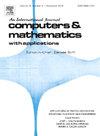热电绝缘双功能分层斗篷材料的自适应设计与自适应有限元验证
IF 2.5
2区 数学
Q1 MATHEMATICS, APPLIED
引用次数: 0
摘要
本文利用转换热力学和转换静电学原理,结合自适应有限元法,设计了一种具有热和绝缘功能的双功能超材料器件。我们设计这种隐身材料的主要思想是首先通过变换热学和变换静电原理推导出随空间位置变化的理想隐身材料参数(通常表示为函数矩阵)。我们认识到,这些参数在空间上的变化率存在显著差异。根据材料参数的实际特性,根据其空间变化率的大小进行自适应分层设计。在参数变化剧烈的地区,采用更细的分层,而在参数变化相对平缓的地区,采用更粗的分层。该方法旨在提高隐身器件的可制造性,使双功能电热隐身器件的设计更有效。为了验证该方法的可行性,采用自适应有限元方法对所提出的器件进行了数值模拟。数值结果验证了本文提出的自适应分层设计策略的合理性,并为材料的实际制造提供了合理的方案。本文章由计算机程序翻译,如有差异,请以英文原文为准。
Adaptive design and adaptive finite element verification of bifunctional layer-wise cloak metamaterials for thermal and electrical insulation
In this paper, a bifunctional metamaterial device with thermal and insulating functions is designed by utilizing the principles of transformational thermodynamics and transformational electrostatics in combination with the adaptive finite element method. Our main idea in designing this stealth material is to first derive the ideal stealth material parameters (typically represented as a function matrix) that vary with spatial position through the principles of transformation thermotics and transformation electrostatics. We recognize that there are significant differences in the rate of variation of these parameters in space. Based on the actual characteristics of the material parameters, we perform adaptive layered design according to the magnitude of their spatial variation rates. In regions where the parameters change drastically, finer layering is employed, while in areas with relatively gentle parameter variations, coarser layering is used. This method aims to enhance the manufacturability of stealth devices, enabling the design of dual-functional electrothermal stealth devices in a more efficient manner In order to verify the feasibility of this approach, an adaptive finite element method has been used to numerically simulate the proposed device. The numerical results validate the rationality of the adaptive layering design strategy proposed in this paper and suggest a reasonable scheme for the actual fabrication of the material.
求助全文
通过发布文献求助,成功后即可免费获取论文全文。
去求助
来源期刊

Computers & Mathematics with Applications
工程技术-计算机:跨学科应用
CiteScore
5.10
自引率
10.30%
发文量
396
审稿时长
9.9 weeks
期刊介绍:
Computers & Mathematics with Applications provides a medium of exchange for those engaged in fields contributing to building successful simulations for science and engineering using Partial Differential Equations (PDEs).
 求助内容:
求助内容: 应助结果提醒方式:
应助结果提醒方式:


